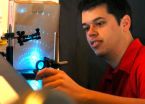(Press-News.org) A simple technique for stamping patterns invisible to the human eye onto a special class of nanomaterials provides a new, cost-effective way to produce novel devices in areas ranging from drug delivery to solar cells.
The technique was developed by Vanderbilt University engineers and described in the cover article of the May issue of the journal Nano Letters.
The new method works with materials that are riddled with tiny voids that give them unique optical, electrical, chemical and mechanical properties. Imagine a stiff, sponge-like material filled with holes that are too small to see without a special microscope.
For a number of years, scientists have been investigating the use of these materials – called porous nanomaterials – for a wide range of applications including drug delivery, chemical and biological sensors, solar cells and battery electrodes. There are nanoporous forms of gold, silicon, alumina, and titanium oxide, among others.
Simple stamping
A major obstacle to using the materials has been the complexity and expense of the processing required to make them into devices.
Now, Associate Professor of Electrical Engineering Sharon M. Weiss and her colleagues have developed a rapid, low-cost imprinting process that can stamp out a variety of nanodevices from these intriguing materials.
"It's amazing how easy it is. We made our first imprint using a regular tabletop vise," Weiss said. "And the resolution is surprisingly good."
The traditional strategies used for making devices out of nanoporous materials are based on the process used to make computer chips. This must be done in a special clean room and involves painting the surface with a special material called a resist, exposing it to ultraviolet light or scanning the surface with an electron beam to create the desired pattern and then applying a series of chemical treatments to either engrave the surface or lay down new material. The more complicated the pattern, the longer it takes to make.
About two years ago, Weiss got the idea of creating pre-mastered stamps using the complex process and then using the stamps to create the devices. Weiss calls the new approach direct imprinting of porous substrates (DIPS). DIPS can create a device in less than a minute, regardless of its complexity. So far, her group reports that it has used master stamps more than 20 times without any signs of deterioration.
Process can produce nanoscale patterns
The smallest pattern that Weiss and her colleagues have made to date has features of only a few tens of nanometers, which is about the size of a single fatty acid molecule. They have also succeeded in imprinting the smallest pattern yet reported in nanoporous gold, one with 70-nanometer features.
The first device the group made is a "diffraction-based" biosensor that can be configured to identify a variety of different organic molecules, including DNA, proteins and viruses. The device consists of a grating made from porous silicon treated so that a target molecule will stick to it. The sensor is exposed to a liquid that may contain the target molecule and then is rinsed off. If the target was present, then some of the molecules stick in the grating and alter the pattern of reflected light produced when the grating is illuminated with a laser.
According to the researchers' analysis, when such a biosensor is made from nanoporous silicon it is more sensitive than those made from ordinary silicon.
The Weiss group collaborated with colleagues in Chemical and Biomolecular Engineering to use the new technique to make nano-patterned chemical sensors that are ten times more sensitive than another type of commercial chemical sensor called Klarite that is the basis of a multimillion-dollar market.
The researchers have also demonstrated that they can use the stamps to make precisely shaped microparticles by a process called "over-stamping" that essentially cuts through the nanoporous layer to free the particles from the substrate. One possible application for microparticles made this way from nanoporous silicon are as anodes in lithium-ion batteries, which could significantly increase their capacity without adding a lot of weight.
Vanderbilt University has applied for a patent on the DIPS method.
INFORMATION:
Vanderbilt graduate student Judson D. Ryckman, Marco Liscidini, University of Pavia and John E. Sipe, University of Toronto, contributed to the research, which was supported by grants from the U.S. Army Research Office, INNESCO project, The National Sciences and Engineering Research Council of Canada and a Graduate Research Fellowship from the National Science Foundation.
Stamping out low cost nanodevices
2011-06-01
ELSE PRESS RELEASES FROM THIS DATE:
Smyrna Georgia Hotel Near Cobb Galleria Provides Lodging to Blade Show & International Cutlery Fair Attendees
2011-06-01
Hampton Inn & Suites Atlanta Galleria hotel, a premier Smyrna Georgia Hotel near Vinings, is an ideal place for travelers to stay who are planning to attend the Blade Show & International Cutlery Fair. The event will be held June 10-12, 2011 at Atlanta's Cobb Galleria Centre. It is the world's largest combined show of handmade, factory and antique knives.
The Blade Show and International Cutlery Fair will showcase over 700 tables and nearly 175 factory booths and products. In addition, the event will feature the Blade Magazine Knife of the Year awards, Blade ...
Atlanta Perimeter Hotel Offers Nearby Lodging to Guests Attending The Monkees at Chastain Park Amphitheater
2011-06-01
The Holiday Inn Express & Suites Atlanta Perimeter Hotel North offers convenient lodging to guests attending The Monkees at Chastain Park Amphitheater on Friday June 3, 2011 at 7:00pm. Part of Delta Classic Chastain Concerts presented by Atlanta Symphony Orchestra, The Monkees 45th Anniversary Tour features original group members Davy Jones, Micky Dolenz and Peter Tork. This is a table set-up concert; coolers and carry-ins are allowed.
The Monkees hit singles and television show debuted 45 years ago. Now in concert again for the first time in a decade, The Monkees ...
Storing seeds for a rainy day -- or in this case, a fire
2011-06-01
As mountain pine beetles march across the forests of western North America, these insects may kill millions of pine trees during a single outbreak. A rise in overall temperatures over the past several years has increased the range of mountain pine beetles, resulting in an epidemic and possibly making this mountain pine beetle infestation the largest forest-insect blight to occur in North America.
Dr. Francois Teste and colleagues from the University of Alberta in Canada have been investigating the effect of mountain pine beetle outbreaks on lodgepole pines in British ...
Kids who bully, are aggressive are twice as likely to have sleep problems
2011-06-01
Ann Arbor, Mich. – Children who are bullies or have conduct problems at school, are more likely to be sleepy during the day according to University of Michigan Medical School researchers.
Researchers looked at elementary school students in the Ypsilanti, Michigan public schools who had exhibited conduct problems like bullying or discipline referrals and found that there was a two-fold higher risk for symptoms of sleep-disordered breathing, particularly daytime sleepiness among these students. The study was published last week in the journal Sleep Medicine.
"What this ...
More than one-third of California teens do not participate in school physical education
2011-06-01
Despite a state requirement that public middle and high school students get 400 minutes of physical education every 10 days, approximately 1.3 million — more than a third (38 percent) of all adolescents enrolled in California public schools — do not participate in any school-based physical education classes, according to a new policy brief from the UCLA Center for Health Policy Research.
Research has shown that a lack of physical activity is associated with obesity, diabetes and other chronic conditions, while regular physical activity is associated with increased ...
Why childhood obesity? It's so much more than what kids eat
2011-06-01
URBANA –University of Illinois scientists from a variety of disciplines have teamed up to examine the factors that contribute to childhood obesity. Why? Because individual researchers have found that the problem is too complicated for any of them to tackle alone.
"Our Strong Kids team members are looking at such diverse factors as genetic predisposition, the effect of breastfeeding, how much TV a child watches, and the neighborhood he lives in, among many others," said Kristen Harrison of the U of I's Division of Nutritional Sciences. "It seems like the answer should ...
2 NASA satellites see Typhoon Songda weaken and move past Japan
2011-06-01
NASA's Tropical Rainfall Measuring Mission and Aqua satellite provided forecasters some insights into the behavior of Super Typhoon Songda over the past weekend. Former Super typhoon Songda brought rainfall to parts of Japan over the weekend and today marine warnings for high surf remain in several Sub-prefecture regions as extra-tropical depression Sondga's remnants push further out to sea.
Sub-prefecture regions of Nemuro Chiho, Kushiro Chiho, and Tokachi Chiho still have high wave advisories in place today, May 31, 2011, from the Japanese Meteorological Agency as Sondga's ...
Perimeter Hotel in Atlanta Lets Guest Escape with SPG Getaway Free
2011-06-01
Sheraton Atlanta Perimeter Hotel North, located near Atlanta Perimeter Center, announces a new special savings deal that that lets travelers to Escape with Starwood Preferred Guest (SPG) Getaway Free. Guests can register by June 30 and earn a Free Award Night redeemable at over 200 luxury resorts around the world when they stay three times from now through July 31, 2011.
The Escape with SPG Getaway lets guests:
- Earn one Free Award Night for every three stays at over 1,000 hotels and resorts worldwide, including the Sheraton Atlanta Perimeter Hotel North
- Redeem ...
ER visits persist for children with mental health problems despite regular outpatient care
2011-06-01
Johns Hopkins Children's Center scientists have found that having a regular outpatient mental health provider may not be enough to prevent children and teens with behavioral problems from repeatedly ending up in the emergency room. The study is published in the June 1 issue of the journal Psychiatric Services.
Analyzing more than 2,900 records of pediatric patients, ages 3 to 17, treated at the Hopkins Children's ER for mental health crises over eight years, the investigators found that 338 of them (12 percent) returned to the ER within six months of their initial visit. ...
NYC Outward Bound to Honor NYC Schools Chancellor Walcott at Annual Gala, June 7
2011-06-01
On Tuesday evening, June 7, New York City Outward Bound (http://www.nycoutwardbound.org) will honor New York City Schools Chancellor Dennis Walcott at a gala event at Gotham Hall expected to raise over $1 million in support of the achievements of the organization's now-Citywide network of Expeditionary Learning schools. Students Katherine Wei, Marsh Avenue Expeditionary Learning School and Danya Gutierrez, Washington Heights Expeditionary Learning School, will present Walcott with the annual Educational Leadership Award, bestowed on an individual who has demonstrated commitment ...



